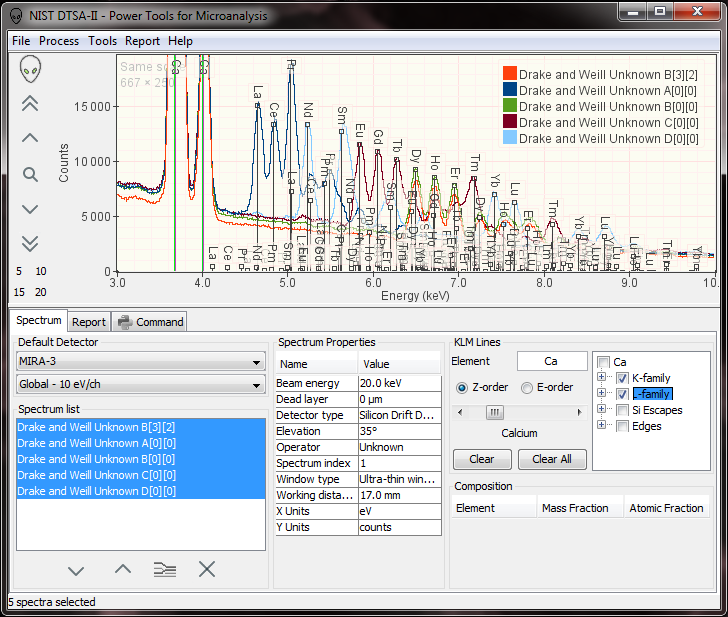NIST DTSA-II
NIST DTSA-II builds on the best available algorithms in the literature to simulate, quantify and plan energy dispersive x-ray analysis measurements. The program implements analytical and Monte Carlo models for simulating x-ray spectra that can be compared directly to measured spectra. The program implements the best available algorithms (including Filter-fitting and Pouchou and Pichoir’s XPP matrix correction algorithm) to provide the most accurate quantitative analysis available using energy dispersive detectors. Finally, DTSA-II provides tools to help the analyst select the optimal standards and suitable instrument conditions to make accurate and precise measurements of composition.
Software
http://www.cstl.nist.gov/div837/837.02/epq/dtsa2/index.html
Related Publications
Newbury, D. E. and Ritchie, N. W. M. (2013), 'Is Scanning Electron Microscopy/Energy Dispersive X-ray Spectrometry (SEM/EDS) Quantitative?', Scanning 35(3), 141-168.
Newbury, D. E. and Ritchie, N. W. M. (2015), 'Performing elemental microanalysis with high accuracy and high precision by scanning electron microscopy/silicon drift detector energy-dispersive X-ray spectrometry (SEM/SDD-EDS)', Journal of Materials Science 50(2), 493-518.
Ritchie, N. W. M. (2009), 'Spectrum Simulation in DTSA-II', Microscopy and Microanalysis 15(5), 454-468.
Ritchie, N. (2005), 'A new Monte Carlo application for complex sample geometries', Surface and Interface Analysis 37(11), 1006-1011.
Ritchie, N. W. M., Newbury, D. E. and Davis, J. M. (2012), 'EDS Measurements of X-Ray Intensity at WDS Precision and Accuracy Using a Silicon Drift Detector', Microscopy and Microanalysis 18(4), 892-904.
Newbury, D. E. and Ritchie, N. W. M. (2013), 'Elemental mapping of microstructures by scanning electron microscopy-energy dispersive X-ray spectrometry (SEM-EDS): extraordinary advances with the silicon drift detector (SDD)', Journal of Analytical Atomic Spectrometry 28(7), 973-988.
Ritchie, N. W. M. (2010), 'Using DTSA-II to Simulate and Interpret Energy Dispersive Spectra from Particles', Microscopy and Microanalysis 16(3), 248-258.
Newbury, D. E. and Ritchie, N. W. M. (2018), 'An Iterative Qualitative-Quantitative Sequential Analysis Strategy for Electron-Excited X-ray Microanalysis with Energy Dispersive Spectrometry: Finding the Unexpected Needles in the Peak Overlap Haystack', Microscopy and Microanalysis 24(4), 350-373.
Ritchie, N. W. M. (2020), 'Embracing Uncertainty: Modeling the Standard Uncertainty in Electron Probe Microanalysis-Part I', Microscopy and Microanalysis 26(3), 469-483.
Boettinger, W. J., Newbury, D. E., Ritchie, N. W. M., Williams, M. E., Kattner, U. R., Lass, E. A., Moon, K. W., Katz, M. B. and Perepezko, J. H. (2019), 'Solidification of Ni-Re Peritectic Alloys', Metallurgical and Materials Transactions A – Physical Metallurgy and Materials Science 50A(2), 772-788.
Newbury, D. E. and Ritchie, N. W. M. (2022), 'Energy-Dispersive X-Ray Spectrum Simulation with NIST DTSA-II: Comparing Simulated and Measured Electron-Excited Spectra', Microscopy and Microanalysis 28(6), 1905-1916.
Newbury, D. E. and Ritchie, N. W. M. (2021), 'Quantitative Electron-Excited X-ray Microanalysis With Low-Energy L-shell X-ray Peaks Measured With Energy-Dispersive Spectrometry', Microscopy and Microanalysis 27(6), 1375-1408.
Uses
NIST DTSA-II is used in industrial, academic, forensic and laboratory environments. Consistent reliable results are appreciated in industry and laboratories and the simulation and quantification are used in many graduate and undergraduate microanalysis courses.
Sample Screenshots

NIST DTSA-II with four complex Drake and Weill rare-earth containing spectra.
Contact
-
(301) 975-3929

